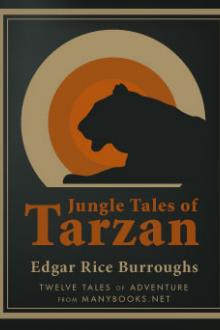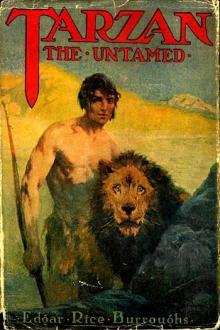Tarzan the Terrible, Edgar Rice Burroughs [books on motivation .TXT] 📗

- Author: Edgar Rice Burroughs
- Performer: 0345030060
Book online «Tarzan the Terrible, Edgar Rice Burroughs [books on motivation .TXT] 📗». Author Edgar Rice Burroughs
Pan-at-lee, descended from a long line of hunters, assumed that Tarzan would move up wind and in this direction she sought his tracks, which she soon found well marked, since he had made no effort to conceal them. She moved rapidly until she reached the point at which Tarzan had taken to the trees. Of course she knew what had happened; since her own people were semi-arboreal; but she could not track him through the trees, having no such well-developed sense of scent as he.
She could but hope that he had continued on up wind and in this direction she moved, her heart pounding in terror against her ribs, her eyes glancing first in one direction and then another. She had reached the edge of a clearing when two things happened—she caught sight of Tarzan bending over a dead deer and at the same instant a deafening roar sounded almost beside her. It terrified her beyond description, but it brought no paralysis of fear. Instead it galvanized her into instant action with the result that Pan-at-lee swarmed up the nearest tree to the very loftiest branch that would sustain her weight. Then she looked down.
The thing that Tarzan saw charging him when the warning bellow attracted his surprised eyes loomed terrifically monstrous before him—monstrous and awe-inspiring; but it did not terrify Tarzan, it only angered him, for he saw that it was beyond even his powers to combat and that meant that it might cause him to lose his kill, and Tarzan was hungry. There was but a single alternative to remaining for annihilation and that was flight—swift and immediate. And Tarzan fled, but he carried the carcass of Bara, the deer, with him. He had not more than a dozen paces start, but on the other hand the nearest tree was almost as close. His greatest danger lay, he imagined, in the great, towering height of the creature pursuing him, for even though he reached the tree he would have to climb high in an incredibly short time as, unless appearances were deceiving, the thing could reach up and pluck him down from any branch under thirty feet above the ground, and possibly from those up to fifty feet, if it reared up on its hind legs.
But Tarzan was no sluggard and though the gryf was incredibly fast despite its great bulk, it was no match for Tarzan, and when it comes to climbing, the little monkeys gaze with envy upon the feats of the ape-man. And so it was that the bellowing gryf came to a baffled stop at the foot of the tree and even though he reared up and sought to seize his prey among the branches, as Tarzan had guessed he might, he failed in this also. And then, well out of reach, Tarzan came to a stop and there, just above him, he saw Pan-at-lee sitting, wide-eyed and trembling.
“How came you here?” he asked.
She told him. “You came to warn me!” he said. “It was very brave and unselfish of you. I am chagrined that I should have been thus surprised. The creature was up wind from me and yet I did not sense its near presence until it charged. I cannot understand it.”
“It is not strange,” said Pan-at-lee. “That is one of the peculiarities of the gryf—it is said that man never knows of its presence until it is upon him—so silently does it move despite its great size.”
“But I should have smelled it,” cried Tarzan, disgustedly.
“Smelled it!” ejaculated Pan-at-lee. “Smelled it?”
“Certainly. How do you suppose I found this deer so quickly? And I sensed the gryf, too, but faintly as at a great distance.” Tarzan suddenly ceased speaking and looked down at the bellowing creature below them—his nostrils quivered as though searching for a scent. “Ah!” he exclaimed. “I have it!”
“What?” asked Pan-at-lee.
“I was deceived because the creature gives off practically no odor,” explained the ape-man. “What I smelled was the faint aroma that doubtless permeates the entire jungle because of the long presence of many of the creatures—it is the sort of odor that would remain for a long time, faint as it is.
“Pan-at-lee, did you ever hear of a triceratops? No? Well this thing that you call a gryf is a triceratops and it has been extinct for hundreds of thousands of years. I have seen its skeleton in the museum in London and a figure of one restored. I always thought that the scientists who did such work depended principally upon an overwrought imagination, but I see that I was wrong. This living thing is not an exact counterpart of the restoration that I saw; but it is so similar as to be easily recognizable, and then, too, we must remember that during the ages that have elapsed since the paleontologist’s specimen lived many changes might have been wrought by evolution in the living line that has quite evidently persisted in Pal-ul-don.”
“Triceratops, London, paleo—I don’t know what you are talking about,” cried Pan-at-lee.
Tarzan smiled and threw a piece of dead wood at the face of the angry creature below them. Instantly the great bony hood over the neck was erected and a mad bellow rolled upward from the gigantic body. Full twenty feet at the shoulder the thing stood, a dirty slate-blue in color except for its yellow face with the blue bands encircling the eyes, the red hood with the yellow lining and the yellow belly. The three parallel lines of bony protuberances down the back gave a further touch of color to the body, those following the line of the spine being red, while those on either side are yellow. The five-and three-toed hoofs of the ancient horned dinosaurs had become talons in the gryf, but the three horns, two large ones above the eyes and a median horn on the nose, had persisted through all the ages. Weird and terrible as was its appearance Tarzan could not but admire the mighty creature looming big below him, its seventy-five feet of length majestically typifying those things which all his life the ape-man had admired—courage and strength. In that massive tail alone was the strength of an elephant.
The wicked little eyes looked up at him and the horny beak opened to disclose a full set of powerful teeth.
“Herbivorous!” murmured the ape-man. “Your ancestors may have been, but not you,” and then to Pan-at-lee: “Let us go now. At the cave we will have deer meat and then—back to Kor-ul-ja and Om-at.”
The girl shuddered. “Go?” she repeated. “We will never go from here.”
“Why not?” asked Tarzan.
For answer she but pointed to the gryf.
“Nonsense!” exclaimed the man. “It cannot climb. We can reach the cliff through the trees and be back in the cave before it knows what has become of us.”
“You do not know the gryf,” replied Pan-at-lee gloomily.
“Wherever we go it will follow and always it will be ready at the foot of each tree when we would descend. It will never give us up.”
“We can live in the trees for a long time if necessary,” replied Tarzan, “and sometime the thing will leave.”
The girl shook her head. “Never,” she said, “and then there are the Tor-o-don. They will come and kill us and after eating a little will throw the balance to the gryf—the gryf and Tor-o-don are friends, because the Tor-o-don shares his food with the gryf.”
“You may be right,” said Tarzan; “but even so I don’t intend waiting here for someone to come along and eat part of me and then feed the balance to that beast below. If I don’t get out of this place whole it won’t be my fault. Come along now and we’ll make a try at it,” and so saying he moved off through the tree tops with Pan-at-lee close behind. Below them, on the ground, moved the horned dinosaur and when they reached the edge of the forest where there lay fifty yards of open ground to cross to the foot of the cliff he was there with them, at the bottom of the tree, waiting.
Tarzan looked ruefully down and scratched his head.
7Jungle Craft
Presently he looked up and at Pan-at-lee. “Can you cross the gorge through the trees very rapidly?” he questioned.
“Alone?” she asked.
“No,” replied Tarzan.
“I can follow wherever you can lead,” she said then.
“Across and back again?”
“Yes.”
“Then come, and do exactly as I bid.” He started back again through the trees, swiftly, swinging monkey-like from limb to limb, following a zigzag course that he tried to select with an eye for the difficulties of the trail beneath. Where the underbrush was heaviest, where fallen trees blocked the way, he led the footsteps of the creature below them; but all to no avail. When they reached the opposite side of the gorge the gryf was with them.
“Back again,” said Tarzan, and, turning, the two retraced their high-flung way through the upper terraces of the ancient forest of Kor-ul-gryf. But the result was the same—no, not quite; it was worse, for another gryf had joined the first and now two waited beneath the tree in which they stopped.
The cliff looming high above them with its innumerable cave mouths seemed to beckon and to taunt them. It was so near, yet eternity yawned between. The body of the Tor-o-don lay at the cliff’s foot where it had fallen. It was in plain view of the two in the tree. One of the gryfs walked over and sniffed about it, but did not offer to devour it. Tarzan had examined it casually as he had passed earlier in the morning. He guessed that it represented either a very high order of ape or a very low order of man—something akin to the Java man, perhaps; a truer example of the pithecanthropi than either the Ho-don or the Waz-don; possibly the precursor of them both. As his eyes wandered idly over the scene below his active brain was working out the details of the plan that he had made to permit Pan-at-lee’s escape from the gorge. His thoughts were interrupted by a strange cry from above them in the gorge.
“Whee-oo! Whee-oo!” it sounded, coming closer.
The gryfs below raised their heads and looked in the direction of the interruption. One of them made a low, rumbling sound in its throat. It was not a bellow and it did not indicate anger. Immediately the “Whee-oo!” responded. The gryfs repeated the rumbling and at intervals the “Whee-oo!” was repeated, coming ever closer.
Tarzan looked at Pan-at-lee. “What is it?” he asked.
“I do not know,” she replied. “Perhaps a strange bird, or another horrid beast that dwells in this frightful place.”





Comments (0)